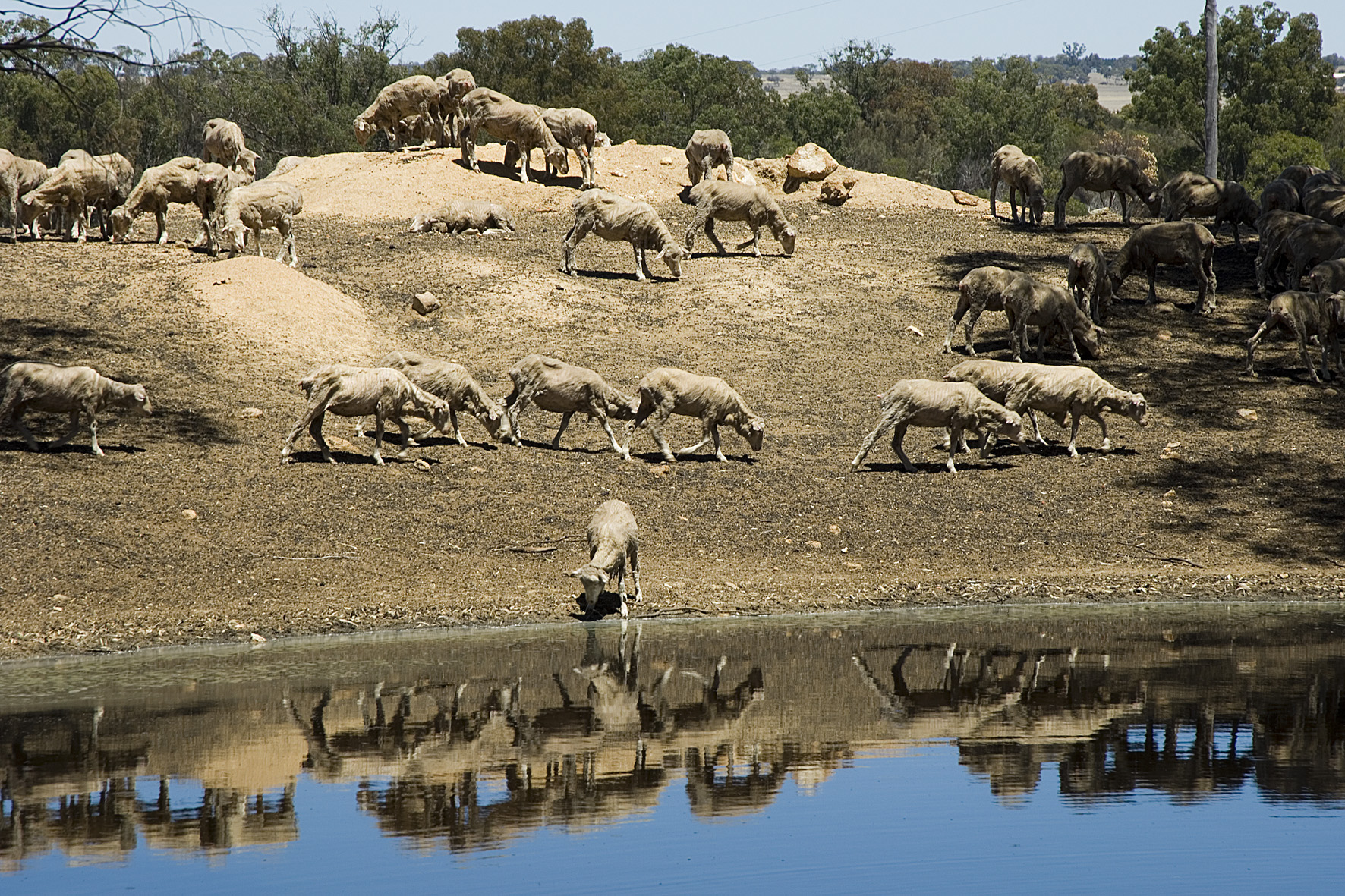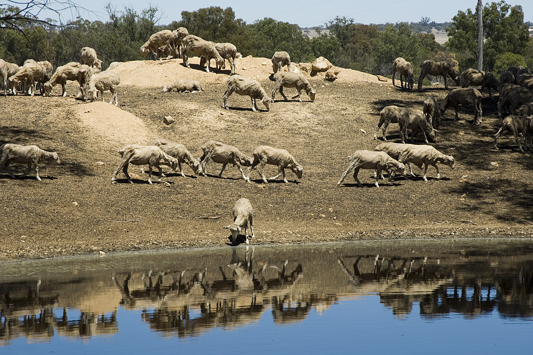Organic material washed into dams can lead to water becoming unattractive to livestock and possibly toxic. This page explores ways to prevent and treat contaminated farm dams.
Contamination and the problems it causes
Heavy rainfall resulting in overland flows can wash large amounts of organic material (straw and manure) into farm dams. The material will float for up to 48 hours before sinking. Contamination can then cause the water to be temporarily unpalatable to livestock, resulting in animals not drinking and losing condition.
Toxicity
Contaminated water is not usually poisonous to healthy sheep, but it may be harmful to young or weak livestock. Under some conditions, contamination can lead to toxic blue-green algae growing in the water. Under those conditions, remove livestock immediately and avoid poisoning more livestock.
Anaerobic conditions
Organic materials in dam water provide ideal food for bacteria and algae. These organisms grow rapidly, using up all the free oxygen in the water, creating anaerobic conditions leading to putrefaction. Signs of putrefaction are dark water, a bad smell and black scum around the edge of the dam.
Thick scum around the water's edge may prevent livestock reaching the water.
Managing contamination
The main carrier of contamination is rapid water flow from thunderstorms during the dry season, carrying loose organic material from the catchment. There are several practical ways of managing contamination: prevention, removal and treatment.

Preventing contamination of dams
Prevention is better than treating the problem. The following are recommend:
- Silt traps at the dam entrance.
- Stable vegetation groundcover leading to the silt trap, with grazing control.
- Netting or fencing upslope of the dam to trap wind-borne or water-borne. material, see video: How to build sediment fence.
- Surface water earthworks to manage heavy water flows leading to the dam.
In severe conditions, such as floods and cyclones, nothing will prevent all contamination. To prepare for such conditions, we recommend having skimmers (described above) readily available.
Removing floating organic matter from contaminated dams
The best option to remove contamination is to skim material before it sinks, which means responding quickly after heavy run-off.
Use a hand-operated 'boom' to skim floating material:
- Make the boom from 30 m of link mesh, 45 cm wide, with plastic milk bottle floats wired along alternate sides of the top edge.
- Tie one end of the boom to a stake/quad bike/farm ute on the edge of the dam and attach a boom control rope to the other end (sufficiently long to walk around the dam wall).
- Pull the free end of the boom – by the boom control rope – in a semi-circle and drag a load of rubbish to the edge of the dam
- Tie the boom control rope to a steel post driven into the dam bank: this will hold the rubbish on the dam bank.
- Remove the rubbish from the water and haul it over the dam wall using a pipe frame and wire mesh 'cage' pulled by a vehicle hitched to the cage by 2 parallel tow ropes. Once emptied, drag the cage back to the water’s edge and lift out over the next load of rubbish.
If possible, use this method to remove sludge from the edges and the bottom of the dam.
Check dams regularly during summer for contamination, water level and salinity. Dams may require emergency chlorination of water or treatment for toxic algae blooms.
Treating contaminated water
You can improve polluted water quality (look, taste and smell) by aeration and chemical treatment. Aeration will occur naturally over time (2 to 3 weeks) if organic contamination is removed. Options for increasing aeration are:
- spraying the water into the air
- bleeding air into the intake side of a pump
- agitating the water with propellers or paddles
- cascading it over baffles into a settling tank.
Organic material remaining in the dam will continue to break down and turn the water anaerobic again. In this case, pump water to a tank as part of the aeration process to protect valuable water.
Chemical treatment can improve palatability of contaminated water. Chlorination is the most common chemical treatment. It is best used on water relatively clean of suspended organic material.
We recommend these steps for chlorination:
- add a flocculant to the dam water to remove suspended clay
- pump to a tank or trough
- then batch chlorinate.
Chlorination in dams may not be effective because of the high chlorine demand in clay dam lining, suspended clay and organic matter in the silt. If chlorination in the dam is the only choice, add a flocculant first, then pour in and mix the chlorine to ensure there is enough free chlorine to have the disinfectant effect.
Note that chlorination is toxic to fish and yabbies in the dam.
Only barley straw (not other cereal straws) releases chemicals that inhibit blue-green algae. Barley straw treatment is not harmful to plants, fish or crustaceans. Barley straw used this way works best as a preventative, not a treatment for already algae contaminated dams.
Adding barley straw to contaminated or potentially contaminated water has 2 effects:
- Nutrient stripping – the high carbon-to-nitrogen ratio of barley straw means that when it breaks down it uses available nitrogen in the water. This reduces conditions favourable to algae growth.
- Release of chemicals that reduce the growth of harmful blue-green algae – Salcolin A and Salcolin B (both flavonolignans) have been identified as active agents against Microcystis sp. Barley straw is effective at preventing algal blooms, but is not effective at treating existing blooms.
Rate
We recommend adding barley straw to a dam at 50 g/m2 of surface area of the dam water. This rate releases enough chemicals to last for up to 6 months.
Timing
Add the barley straw in late spring to early summer, before water conditions favour blue-green algae growth. Barley straw is likely to be more available after harvest, in early summer, and the straw is more effective in warmer water.
Adding the straw
Place the straw in coarse-weave bags (such as onion bags) and suspend the bags from floats, such as sealed large drink bottles, drums or a pontoon. The floating straw bags will sink as the straw rots. Remove the straw at this stage and spread it on paddocks away from the dam.
If there is an incoming flow of water, the straw net should be placed where there is a continuous flow of water over and through the straw. This will help to keep the straw oxygenated and spread the active chemicals throughout the water surface.
Aeration, chlorination and barley straw may be done at the same time.
Cleaning dams after organic material has accumulated on the bottom
Silt and organic material contain a lot of nutrients and, when washed into dams, increase the chance of algal blooms. Warm, still sunny days and nutrient-rich water provide the perfect environment for algal growth. Silt also reduces a dam's storage volume and increases the proportion of water lost to evaporation.
De-silting dams should reduce nutrient levels and the risk of algal blooms.

